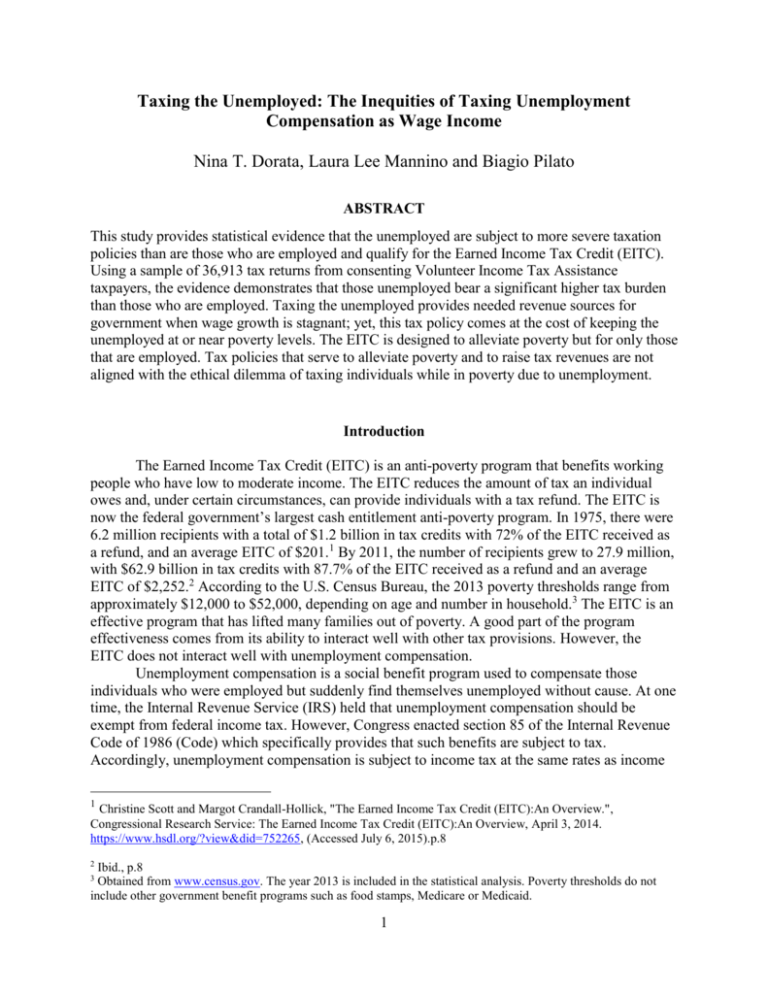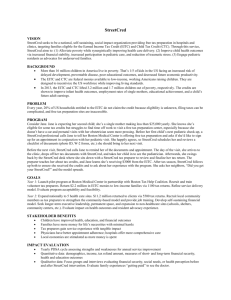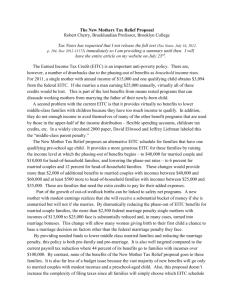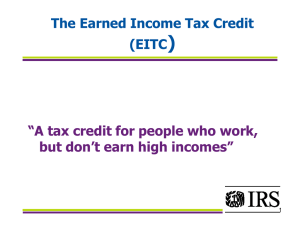Taxing the Unemployed: The Inequities of
advertisement

Taxing the Unemployed: The Inequities of Taxing Unemployment Compensation as Wage Income Nina T. Dorata, Laura Lee Mannino and Biagio Pilato ABSTRACT This study provides statistical evidence that the unemployed are subject to more severe taxation policies than are those who are employed and qualify for the Earned Income Tax Credit (EITC). Using a sample of 36,913 tax returns from consenting Volunteer Income Tax Assistance taxpayers, the evidence demonstrates that those unemployed bear a significant higher tax burden than those who are employed. Taxing the unemployed provides needed revenue sources for government when wage growth is stagnant; yet, this tax policy comes at the cost of keeping the unemployed at or near poverty levels. The EITC is designed to alleviate poverty but for only those that are employed. Tax policies that serve to alleviate poverty and to raise tax revenues are not aligned with the ethical dilemma of taxing individuals while in poverty due to unemployment. Introduction The Earned Income Tax Credit (EITC) is an anti-poverty program that benefits working people who have low to moderate income. The EITC reduces the amount of tax an individual owes and, under certain circumstances, can provide individuals with a tax refund. The EITC is now the federal government’s largest cash entitlement anti-poverty program. In 1975, there were 6.2 million recipients with a total of $1.2 billion in tax credits with 72% of the EITC received as a refund, and an average EITC of $201.1 By 2011, the number of recipients grew to 27.9 million, with $62.9 billion in tax credits with 87.7% of the EITC received as a refund and an average EITC of $2,252.2 According to the U.S. Census Bureau, the 2013 poverty thresholds range from approximately $12,000 to $52,000, depending on age and number in household.3 The EITC is an effective program that has lifted many families out of poverty. A good part of the program effectiveness comes from its ability to interact well with other tax provisions. However, the EITC does not interact well with unemployment compensation. Unemployment compensation is a social benefit program used to compensate those individuals who were employed but suddenly find themselves unemployed without cause. At one time, the Internal Revenue Service (IRS) held that unemployment compensation should be exempt from federal income tax. However, Congress enacted section 85 of the Internal Revenue Code of 1986 (Code) which specifically provides that such benefits are subject to tax. Accordingly, unemployment compensation is subject to income tax at the same rates as income 1 Christine Scott and Margot Crandall-Hollick, "The Earned Income Tax Credit (EITC):An Overview.", Congressional Research Service: The Earned Income Tax Credit (EITC):An Overview, April 3, 2014. https://www.hsdl.org/?view&did=752265, (Accessed July 6, 2015).p.8 2 Ibid., p.8 Obtained from www.census.gov. The year 2013 is included in the statistical analysis. Poverty thresholds do not include other government benefit programs such as food stamps, Medicare or Medicaid. 3 1 earned from the performance of services (i.e., salary, wages). Yet, for purposes of qualifying for the EITC, unemployment compensation is not considered “earned income.” As a result, unemployed individuals do not qualify for the EITC. The outcome of this inequity is that those who are unemployed will be subject to a higher tax burden than those who are employed and thus qualify for the EITC. The Earned Income Tax Credit The EITC began in 1975 as part of the Tax Reduction Act of 1975 (P.L. 94-12). A provision in The Tax Reduction Act of 1975 established this refundable credit for tax filers with very low earned incomes. Although introduced in 1975, the idea behind the EITC goes back to 1971. In 1971, the Nixon administration proposed a program to assist working, but economically disadvantaged, two-parent families with children. The program was to provide guaranteed cash payments from the federal government to eligible recipients. This proposed program was called the Family Assistance Plan. The Family Assistance Plan was designed to replace the federal-state welfare program of Aid to Families with Dependent Children (AFDC).4 In April 1972, the Senate Finance Committee proposed the Work Bonus Plan as an alternative to the Family Assistance Plan.5 These unsuccessful welfare reform proposals were the forerunners to the EITC that we have today. If a taxpayer qualifies for EITC, the taxpayer will have to file a tax return with the IRS, even if no tax is owed or if the taxpayer is not required to file a tax return under the law. Eligible recipients receive the EITC as a reduction in their income tax liability, or as a year-end cash refund from the Treasury if there is no income tax liability, or as a combination of reduced taxes and refund. To claim the EITC on the tax return, all the following conditions must be met: A Social Security number that is valid for employment is necessary The taxpayer’s filing status cannot be married filing separately The taxpayer must be a U.S. citizen or resident alien all year, or a nonresident alien married to a U.S. citizen or resident alien and filing a joint return The taxpayer cannot be a qualifying child of another person The taxpayer cannot file Form 2555 or Form 2555 EZ (related to foreign earned income) The taxpayer must meet the earned income, AGI and investment income limits (income limits change each year), And the taxpayer must meet one of the following: o Have a qualifying child o If the taxpayer does not have a qualifying child, then the taxpayer must: be age 25 but under 65 at the end of the year, live in the United States for more than half the year, and not qualify as a dependent of another person. 4 5 Ibid. p 21. Ibid. p.21. 2 Most importantly, the taxpayer must have earned income from working for someone else or running or operating a farm or business. Unemployment compensation does not qualify as earned income for EITC purposes.6 Expansion as an Anti-Poverty Program The EITC began as a temporary program intended to only last one year. The EITC was extended an additional three years by The Revenue Adjustment Act of 1975 (P.L. 94-164), the Tax Reform Act of 1976 (P.L. 94-455), and the Tax Reduction and Simplification Act of 1977 (P.L. 95-30). In 1978, EITC became a permanent federal tax credit with the passage of the Revenue Act of 1978 (P.L. 95-600). In the 1990’s the EITC became a major component of the federal government’s efforts to reduce poverty, starting with the Omnibus Budget Reconciliation Act (OBRA) of 1990 (P.L. 101-508). The Omnibus Budget Reconciliation Act (OBRA) of 1990 (P.L. 101-508) adjusted the EITC based on family size. The Clinton administration pledged to use the EITC to eliminate poverty for families with a member working full-time at the minimum wage in order to “make work pay.” The OBRA of 1993 (P.L. 103-66) expanded the program again by increasing the EITC credit, especially for families with two or more children. The OBRA of 1993 (P.L. 103-66) also made a major expansion to the EITC by including low-income working adults with no children. This expansion of the EITC was for adults aged 25 to 64 who were not claimed as dependents on anyone else’s tax return. President Obama in his 2014 State of the Union Address, called for an additional expansion of the EITC for childless workers. Shortly thereafter, Congress proposed legislation, such as S. 836 and H.R. 2116 that would expand the EITC by lowering the eligibility age from 25 to 21 for childless workers as well as increasing the credit for these recipients. Although these bills were not enacted by Congress, the proposing of such legislation shows the intent of some members of congress to see an expansion to EITC Year Legislation/Proposal 1971 The Family Assistance Plan 1971-This was a welfare reform measure introduced by the Nixon administration. 1972-74 Work Bonus Plan (1972-1974 Proposals)-This plan was proposed by the Senate Finance Committee as an alternative to the Family Assistance Plan. 1975 . The Tax Reduction Act of 1975 (P.L. 94-12)-This legislation included a provision that established, in Section 32 of the Internal Revenue Code, a refundable credit to tax filers with incomes below $8,000. 1975 The Revenue Adjustment Act of 1975 (P.L. 94-164)-This legislation extended the EITC for one year. 6 "EITC, Earned Income Tax Credit, Questions and Answers." Internal Revenue Service, May 6, 2015. http://www.irs.gov/Credits-&-Deductions/Individuals/Earned-Income-Tax-Credit/EITC. (Accessed July 6, 2015). 3 1976 Tax Reform Act of 1976 (P.L. 94-455)-This legislation extended the EITC for one year. 1977 Tax Reduction and Simplification Act of 1977 (P.L. 95-30)-This legislation extended the EITC for one year. 1978 The Revenue Act of 1978 (P.L. 95-600)-This legislation made the EITC permanent and increased the maximum credit. 1984 The Deficit Reduction Act of 1984 (P.L. 98-369)-This legislation increased the maximum credit. 1986 Tax Reform Act of 1986 (P.L. 99-514)-This legislation increased the EITC and began indexing the credit for inflation. 1990 Omnibus Budget Reconciliation Act (OBRA) of 1990 (P.L. 101-508)-This legislation introduced the adjustment of the credit for family size. 1993 OBRA of 1993 (P.L. 103-66)-This legislation extended the EITC to low-income working adults with no children. 1994 General Agreement on Tariffs and Trade (P.L. 103-465)-This legislation provided EITC eligibility for qualifying families outside the United States if their foreign residence is because of a U.S. military assignment. 1995 Eligibility Limit Based on Investment Income (P.L. 104-7)-This legislation prohibited EITC claims by tax filers whose annual investment income exceeds $2,350. 1996 Personal Responsibility and Work Opportunity Reconciliation Act (P.L. 104-193)-This legislation modified the investment income amount, coordinated the EITC with the $500 per child tax credit, took measures to eliminate fraud and abuse within the program, and denied EITC to undocumented workers. 1997 Taxpayer Relief Act of 1997 (P.L. 105-34)-This legislation denied the EITC to tax filers that had previously made fraudulent or reckless EITC claims. 2001 The Economic Growth and Tax Relief Reconciliation Act of 2001 (EGTRRA; P.L. 107-16)This legislation reduced the marriage penalty, increased the phase-out income levels for married couples filing a joint return. 2004 The Working Families Tax Relief Act of 2004 (P.L. 108-311)-This legislation created a more uniform definition of a child for tax purposes. 2005 The Katrina Emergency Relief Act (P.L. 109-73)-This legislation provided that taxpayers affected by Hurricane Katrina could use their tax year 2004 earned income to compute their 2005 EITC. 2005 The Gulf Opportunity Zone Act of 2005 (P.L. 109-135)-This legislation extended the option to include combat pay. P.L. 109-135 also extended the option of using 2004 income to compute 4 2005 EITC to taxpayers affected by Hurricane Rita. 2006 The Tax Relief and Health Care Act of 2006 (P.L. 109-432)-This legislation extended the option to include combat pay through tax year 2007. 2008 The Heroes Earnings Assistance and Relief Tax Act of 2008 (P.L. 110-245)-This legislation made permanent the option to include combat pay. 2008 The Fostering Connections to Success and Increasing Adoptions Act of 2008 (P.L. 110351)-This legislation clarified the uniform definition of qualifying child for purposes of the dependency exemption, the child credit, the earned income credit, the dependent care credit, and head of household filing status. 2009 The American Recovery and Relief Act of 2009 (ARRA; P.L. 111-5)-This legislation created a new credit rate for taxpayers with three or more eligible children. Year 2010 Legislation/Proposal The Tax Relief, Unemployment Insurance Reauthorization, and Job Creation Act of 2010 (P.L. 111-312)-This legislation extended the EGTRRA and ARRA provisions for two years (through 2012). 2012 The American Taxpayer Relief Act of 2012 (ATRA; P.L. 112-240)-This legislation made permanent the EGTRRA changes and extended the ARRA changes for five years (through tax year 2017). 2013 Earned Income Tax Credit Improvement and Simplification Act of 2013 proposed legislation to expand the EITC by lowering the eligibility age from 25 to 21 for childless workers as well as increasing the credit for these recipients. 2014 White House Budget Proposal – Tax carried interest in investment partnerships as ordinary income and uses the additional tax revenue to expand the EITC. Changes Needed to Increase Anti-Poverty Effectiveness It is clearly the intent of the federal government to use the EITC as a weapon in the war against poverty. There have been twenty-one legislative changes made to the EITC since its inception in 1975. Each legislative change was made to expand and increase the credit and advance its usefulness as an anti-poverty tool. The EITC, along with other tax measures discussed in a paper for the Tax Policy Center titled The War on Poverty Moves to the Tax Code (Burman and Maag, January 2014), confirms that the federal government is prepared to use the Internal Revenue Code to help the working poor. Changing the tax code to consider unemployment benefits for EITC purposes would be consistent with the expansion trend. Yet, that has not happened. Under IRC section 85(a), gross income includes unemployment compensation. Unemployment benefits are subject to income taxation just as the income earned from employment. Although subject to the same type of tax, and the same tax rates as earned income, unemployment benefits are not considered “earned income” for the EITC. This inequitable tax treatment does not further the federal government’s 5 anti-poverty goals. This is an area where policymakers need to do a serious examination and find solutions to the present inequity. Research Methodology We conducted an examination of the tax inequity created by the tax treatment of unemployment benefits using univariate tests of mean differences between different samples of taxpayers. For our examination, we utilized income tax return data supplied by the Voluntary Income Tax Assistance Program (VITA) coordinated by St. John’s University (SJU) in partnership with the Food Bank for New York City (FB). The data was retrieved from approximately 97,074 income tax returns prepared by SJU student volunteers and FB personnel for the tax years 2009 through 2013 for consenting VITA clients. After removing observations of incomplete data and unusable observations, the final sample for this analysis is 36,913 observations. The test variables are described as follows: Filing status - represents the filing status claimed on the tax return; 1=single 2=married filing jointly 3=head of household 4=married filing separately Dependents – the number of dependents claimed on the tax return for which the taxpayer is permitted an exemption; Taxpayer age – the age of the taxpayer; for married filing jointly the taxpayer age is that of the taxpayer name appearing first on the tax return; Adjusted gross income – the amount of adjusted gross income appearing on the federal tax return; Unemployment compensation – the amount of unemployment compensation received by the taxpayer Total refund – the amount of income tax refund from federal, state, and local government sources; Total EITC - the amount of EITC from federal, state, and local government sources; The summary statistics for the sample appears in Table 1. Panel A shows that the mean filing status of the sample is approximately 2.5, which suggests that taxpayers in the sample filed as married filing jointly and head of household, with a dependent (mean=.939). The mean age is about 38 with a mean adjusted gross income of about $14 thousand. Although there are taxpayers who did have a tax liability, the sample shows that on average taxpayers received a refund of about $3.6 thousand. The maximum EITC was about $12 thousand with a mean of $2.1 thousand. On average, unemployment compensation was about $2 thousand. Panels B, C, and D of Table 1split the sample among taxpayers receiving EITC only (N= 26,292), unemployment income only (N=5,476), and taxpayers who received both EITC and unemployment compensation (N=5,145), respectively. Panel B shows that the EITC taxpayers file as married filing jointly or head of household, tend to be older (mean of 38.517), have a mean EITC and total refund of $2,479 and $4,152, respectively. Panel C presents the summary statistics for those taxpayers who receive only unemployment compensation. This group of 6 taxpayers tends to tend to file as single taxpayers (mean of 1.603) and not have dependents (mean of .283). Their mean refund is $777 based on mean unemployment compensation of $8,008. Panel D provides summary statistics for those taxpayers who received EITC and unemployment income. These taxpayers tend to file as either married filing jointly or head of household (mean of 2.772), have one dependent (mean of 1.047) and have an mean adjusted gross income of $14,833. This group of taxpayers received a mean EITC of $2,194, which is lower than the EITC only group of taxpayers. That difference in EITC between these two groups evidence Table 2 presents the univariate analyses of mean differences between the groups of taxpayers. Panel A splits the sample between those taxpayers who solely claimed EITC (N=26,292) from all other taxpayers (N=10,621). The differences in the mean values for EITC sample compared to all other taxpayers are significantly higher for filing status, number of dependents, taxpayer age, total refund, and total EITC (p<.0001). However, for the EITC sample, the difference in the mean values for adjusted gross income is significantly lower compared to all other taxpayers (p<.0001). Panel B of Table 2 splits the sample between those taxpayers who solely receive unemployment income (N=5,475) from all other taxpayers (N=31,438). The differences in the mean values for the unemployment sample compared to all other taxpayers are significantly lower for filing status, number of dependents, taxpayer age, and total refund (p<.0001). The unemployment group has a significantly higher adjusted gross income (p<.0001) and does not receive any EITC. Panel C of Table 2 presents the within sample analysis of the unemployment only (N=5,475) and EITC only (N=26,292) taxpayers. The unemployment group has significantly lower filing status, number of dependents, taxpayer age, and total refunds; yet, a significantly higher adjusted gross income (p<.0001). Summary and Conclusions Overwhelming, the statistical evidence provides support that the unemployed are taxed to a significantly greater extent than those who are earning wages; yet those wages are considered low, near or at poverty levels, and qualify for the EITC. Taxing the unemployed provides an additional source of revenue for government coffers, especially in recessionary times when wage growth is stagnant. Taxing the unemployed is also an ethical dilemma. That ethical dilemma is disregarded when individuals not earning are taxed; yet, the unemployed are at poverty levels, which is a less fortunate situation than the EITC taxpayer has. Poverty does not discriminate between the sources of income of those in less fortunate circumstances. Alleviating poverty comes in the form of a reward as is the case of EITC eligibility. Taxing the unemployed for the benefit of government treasuries makes the case for keeping individuals at the poverty level, a counter-productive outcome. Government policy should consider limiting the taxation of unemployment compensation, either through lower tax rates or eliminating the taxation of unemployment compensation altogether. 7 Table 1 Summary Statistics Panel A Variable Filing Status Dependents Taxpayer Age Adjusted Gross Income Unemployment Compensation Total Refund Total EITC Full Sample N= 36,913 Maximum 4.00 8.00 54.00 Mean 2.563 0.939 38.024 $(3,256.00) $ 49,844.00 $13,911.25 $ $(5,968.00) $ - $ 44,240.00 $ 16,619.00 $ 12,455.10 $ 2,099.95 $ 3,610.09 $ 2,071.69 Minimum 1.00 16.00 Panel B Variable Filing Status Dependents Taxpayer Age Adjusted Gross Income Unemployment Compensation Total Refund Total EITC EITC Only Sample N=26,292 Minimum Maximum Mean 1.00 4.00 2.722 8.00 1.055 16.00 54.00 38.517 $ (3,256.00) $ 49,138.00 $13,652.05 $ $ $ - $ - $ (4,463.00) $ 16,619.00 $ 4,151.63 1.35 $ 12,455.10 $ 2,479.24 8 Table 1 Summary Statistics (continued) Panel C Unemployment Compensation Only Sample N=5,476 Minimum Maximum Mean 1.00 4.00 1.603 7.00 0.283 17.00 54.00 35.666 Variable Filing Status Dependents Taxpayer Age Adjusted Gross Income Unemployment Compensation Total Refund Total EITC $ $ $ $ (684.00) $ 49,844.00 1.00 $14,832.73 $ 44,240.00 $ 8,007.90 (5,968.00) $ 8,678.00 - $ - $ $ 777.34 - Panel D Variable Filing Status Dependents Taxpayer Age Adjusted Gross Income Unemployment Compensation Total Refund Total EITC Both EITC and Unemployment Compensation Sample N=5,145 Minimum Maximum Mean 1.00 4.00 2.772 7.00 1.047 19.00 54.00 38.016 $ $ $ $ 367.00 $ 48,192.00 $ 14,255.25 18.00 $ 33,595.00 (1,305.00) $ 15,523.00 1.35 $ 7,952.85 $ $ $ 5,144.80 3,857.69 2,194.03 9 Table 2 Univariate Tests of Mean Differences Panel A Filing Status Dependents Taxpayer Age Adjusted Gross Income Unemployment Compensation Total Refund Total EITC EITC Only N=26,292 N= 10,621 2.722 2.170 1.055 0.653 38.518 36.803 $ 13,652.00 $ 14,552.90 $ $ 6,621.10 $ $ 4,151.60 2,479.20 Panel B Filing Status Dependents Taxpayer Age Adjusted Gross Income Unemployment Compensation Total Refund Total EITC Panel C Filing Status Dependents Taxpayer Age Adjusted Gross Income Unemployment Compensation Total Refund Total EITC $ $ $ 2,269.50 1,062.80 <.0001 <.0001 Unemployment Only N=5,475 N= 31,438 1.603 2.730 0.283 1.054 35.666 38.435 14,832.70 $ 13,750.80 P-Value <.0001 <.0001 <.0001 <.0001 945.30 4,103.40 2,432.50 <.0001 <.0001 <.0001 Unemployment Only N=5,475 1.603 0.283 35.664 $ 14,832.60 $ 8,008.20 EITC Only N=26,292 2.722 1.055 38.518 $ 13,652.00 $ - P-Value <.0001 <.0001 <.0001 <.0001 <.0001 $ $ $ $ $ 8,007.90 777.30 - $ $ P-Value <.0001 <.0001 <.0001 <.0001 <.0001 777.40 0.00 10 $ $ $ 4,151.60 2,479.20 <.0001 <.0001 References Burman, Len, and Elaine Maag. "The War on Poverty Moves to the Tax Code." Tax Facts. January 6, 2014. Accessed July 6, 2015. http://www.taxpolicycenter.org/UploadedPDF/1001711war-on-poverty-moves-to-tax-code.pdf. "EITC, Earned Income Tax Credit, Questions and Answers." EITC, Earned Income Tax Credit, Questions and Answers. May 6, 2015. Accessed July 6, 2015. http://www.irs.gov/Credits-&Deductions/Individuals/Earned-Income-Tax-Credit/EITC. Lundeen, Andrew, and Kyle Pomerleau. "The Tax Changes in President Obama's Fiscal Year 2015 Budget." Tax Foundation.org. March 5, 2014. Accessed July 6, 2015. http://taxfoundation.org/blog/tax-changes-president-obama-s-fiscal-year-2015-budget. “Policy Basics: The Earned Income Tax Credit." Policy Basics: The Earned Income Tax Credit. January 20, 2015. Accessed July 6, 2015. http://www.cbpp.org/research/policy-basics-theearned-income-tax-credit. Scott, Christine, and Margot Crandall-Hollick. "The Earned Income Tax Credit (EITC):An Overview." Congressional Research Service: The Earned Income Tax Credit (EITC):An Overview. April 3, 2014. Accessed July 6, 2015. https://www.hsdl.org/?view&did=752265. 26 U.S. Code § 32 - Earned income 26 U.S. Code § 85 - Unemployment compensation 11 Author Biographies Nina T. Dorata Ph.D., C.P.A is a Professor and the Assistant Chairperson, of the Department of Accounting and Taxation at the Peter J. Tobin College of Business at St. John’s University located in Queens, NY. Dr. Dorata’s research interests include school district budgeting and financial management, financial reporting and capital markets. Prior to her academic appointments, Dr. Dorata professional experience includes working as an auditor for PricewaterhouseCoopers (formerly Price Waterhouse) and as an Assistant Vice President at E.F. Hutton & Co. Dr. Dorata is the faculty advisor for the Volunteer Income Tax Assistance program at St. John’s University. Professor Laura Lee Mannino J.D., LL.M, CPA is an Associate Professor in the Peter J. Tobin College of Business in the Department of Accounting and Taxation at St. John’s University located in Queens, NY. Professor Mannino was a tax associate at Thelen Reid & Priest, LLP and was a senior associate at PricewaterhouseCoopers. She obtained her audit experience as a senior associate at KPMG. Professor Mannino has presented numerous papers in academic forums and has published in peer reviewed journals such as Journal of Accountancy, New York State Bar Association Journal, Review of Business and Hofstra Law Review. Biagio Pilato J.D., LL.M, C.P.A. is an Assistant Professor of Taxation in the Peter J. Tobin College of Business in the Department of Accounting and Taxation at St. John’s University located in Queens, NY. He is an adjunct professor of law at the St. John’s University School of Law. Professor Pilato has both audit and tax experience with Deloitte (formerly Deloitte Haskins & Sells). He has spent over two decades in private practice as an attorney and as a CPA. His research interests include federal tax policy and retirement planning. 12







